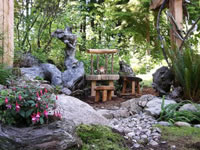Grow a Shade Garden in the dimly lit areas of your garden
I live in northern Indiana. I have two problem spots that are under trees, I can not get anything to grow because of the trees. Arera of shade is 99%. What shrubs can I plant that will grow with out sun light. I have found the perfect spot for a wildlife garden. I love hummingbirds,songbirds,and butterflies, but want to do more for them. Although this is a great area that I have found, there is one problem-shade. It remains shady throughout the day with six hours of sunlight at the most. As you may know, many plants for butterflies and hummingbirds require full sun. PLEASE HELP ME! All I am asking for are some plant names or possibly success stories with shady areas and wildlife. I will be greatful for anything! Thanks!

Levels of Shade in the Garden
Shade is a word, which when used by gardeners can have a multitude of variations. Shade may be the dimly lit area beneath a forest of towering evergreens, or the bright but non sunny spot on the north side of another shrub. As seasons change, an area might receive more or less sun. Is a garden which gets a few hours of morning sun, but shade during the rest of the day considered to be shade? Partial shade? Partial sun? All of these considerations must be taken into account as you make your decisions of what to plant in your shade garden.
The success of your shade garden will of course depend on more than just choosing the right plants. In addition to their light requirements, plants need good soil, good drainage. The soil preparation is pretty much the same as for any vegetable garden, perennials or shrubs. When you are preparing the soil be sure to supply an abundance of good organic compost and mulch to the soil.
Growing Plants in the Shade
There are a few additional considerations to be met when you are creating a garden in the shade. If the shade is the result of trees, you must be prepared to deal with the fact that your shade plants must compete for their food and water, therefore begin a regular watering and feeding program because such soils are also depleted in plant nutrients.
The soil beneath evergreen conifers tends to be more acidic, so be certain to have it tested and adjust the soil pH accordingly. Most common woodland plants grow best in slightly acid soil with a pH of 6 to 6.5. Azaleas, rhododendrons and blueberries thrive when the soil pH is around 5.5. You can purchase simple soil-testing kits from local garden supply outlets. You can also get a complete soil chemistry profile from your County Cooperative Extension office for a small fee. If you plan on growing your shade garden below deciduous trees, do not allow your plants to become suffocated by an over-abundance of leaves in the fall. While a leaf mulch is beneficial through the winter, a too heavy covering of leaves may crush and kill your plants, or possibly lead to disease. You should also be aware that water dripping from overhead branches can cause damage and erosion to the soil as well as your plants.
Spring is a great time to plant your shade garden because temperatures are cool and rainfall is abundant. Roots have a chance to become established before it gets hot and dry. Fall is also a good time to plant; even after air temperatures drop, the soil remains warm, which promotes rapid root growth, preparing the plants for the long cold winter.
Shade Garden Plants
Different plants require different degrees of shade ranging from dense shade to dappled or partial shade. You need to study and understand what kind of light you have to achieve the optimum conditions for what you want to grow.
You need to also consider that a plant which needs full, dense shade to survive the summer in a hot southern state will do just fine in partial shade in a cooler northern location. Instead of trying to change existing conditions, match your plants to the site. It's not only easier on the environment but also a lot less work for you. Most woodland plants will benefit from a rich soil and an environment that insures good air circulation, water and nutrients.
Hummingbird House at Cedar Hill
Willy World, How to build a Hummingbird House?

Similar topics:
- Perennial Plants to Grow in Full Shade
- Plants and Flowers that will Grow in Partial or Light Shade
- Trees and Shrubs to grow in your Shade Garden
- Groundcover Plants to grow in your Shaded area in the Garden
- Non Toxic Shade Garden Plants